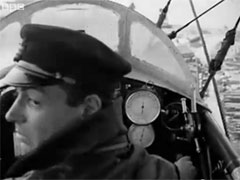 We’re not war historians, by any measure. You won’t catch us watching Nazi documentaries on A&E, and we generally can’t tell one general from another, whether he be Allied or Axis. And the only war history we’ve ever been inclined to read is the work of the late, great Ernie Pyle, who wrote not on the macro level, but the micro, relating the experiences of the common soldier while eschewing more sweeping accounts of battles and campaigns.
We’re not war historians, by any measure. You won’t catch us watching Nazi documentaries on A&E, and we generally can’t tell one general from another, whether he be Allied or Axis. And the only war history we’ve ever been inclined to read is the work of the late, great Ernie Pyle, who wrote not on the macro level, but the micro, relating the experiences of the common soldier while eschewing more sweeping accounts of battles and campaigns.
And if possible, we know even less about World War I than WWII. It’s just long enough ago as to seem out of reach. We don’t really know what caused it and what the end result of it was, other than a simple accounting of the winners and losers. (Hey, we’re not proud of our ignorance here; we’re just being up front about it.)
World War I was fought in such an unusual fashion—all those trenches!—that we too often can’t get our heads around what exactly the participants experienced in fighting it.
This is due in part to the fact that we grew up with World War II movies on the tube constantly. We didn’t watch them terribly frequently, but they were ubiquitous and one couldn’t avoid them entirely. Not so with pictures that depicted the first World War, though we’ve since watched many movies about that War to End All Wars, as our cinematic interest has expanded to include the 1920s and ’30s, when they were made by the dozens.
But perhaps the most moving World War I-related footage we’ve seen dates from the summer of 1919. It was shot by an amateur and on location, not at a studio, using a camera attached to a airplane flying over battle sites along the Western Front and capturing the still-all-too-apparent devastation from above. This footage, shot by a French pilot named (and we’re only guessing at the spelling here) Jacques Tralee de Priveaux, was only recently discovered in a vault in Paris and was included in a recent BBC documentary The First World War from Above. The pilot—we’ll call him Jacques, since we know how to spell that—later joined the French Resistance and was killed during World War II. His daughter, an infant when he died, had only seen photos of her father until she was shown this footage.
Trust us, you’ll be moved by what you see in this clip—by the lingering pain of war that Jacques captured from above nearly 90 years ago, and by his daughter’s emotional first glimpse of her father in his vital and vibrant prime.

